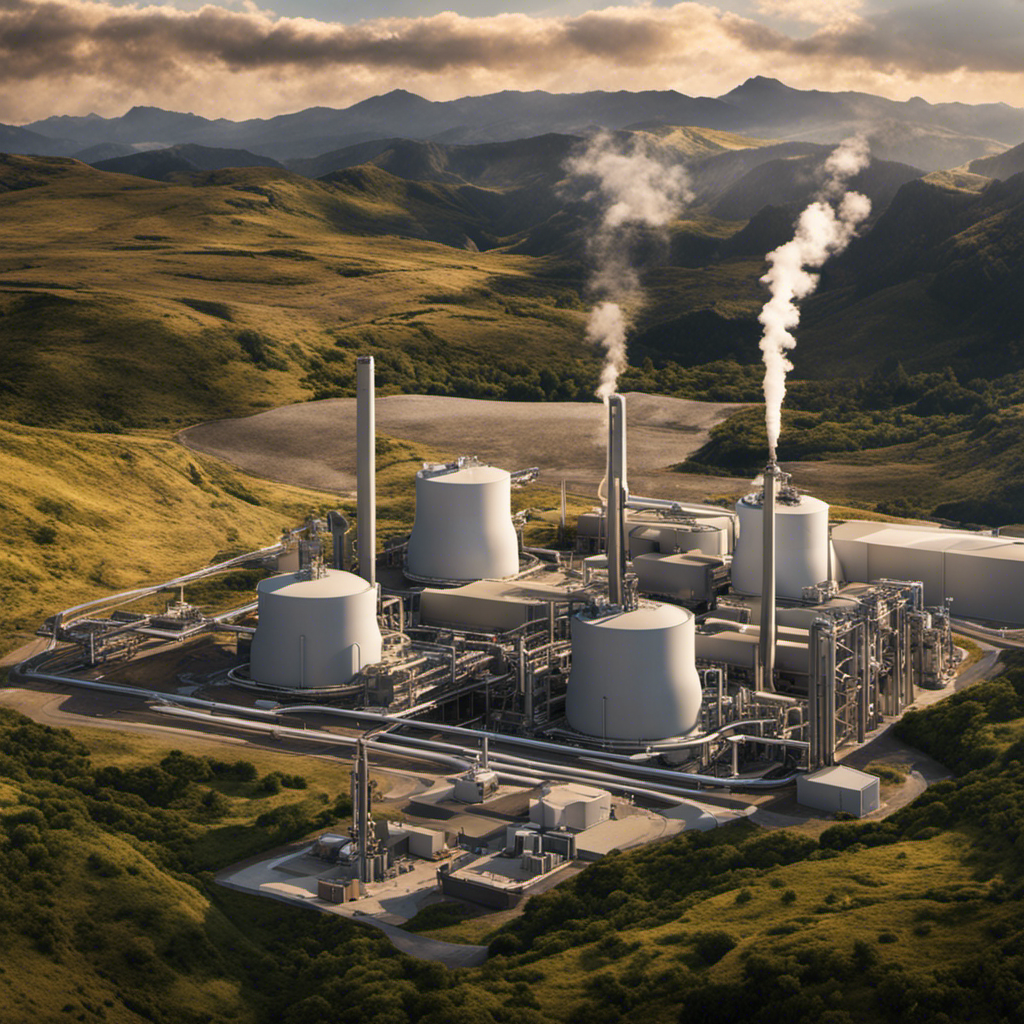Geothermal
How Does Geothermal Energy Cool Houses

As a homeowner who is mindful of energy consumption, I have always been intrigued by the effectiveness of geothermal energy in cooling houses. It’s like using the Earth’s natural air conditioning system.
In this article, we’ll explore how geothermal cooling systems work and why they’re so efficient. From understanding heat exchange to the role of underground loops, we’ll dive into the technical aspects and cost-effectiveness of geothermal cooling.
Get ready to discover a cooler, greener way to beat the heat.
Key Takeaways
- Geothermal cooling utilizes the Earth’s natural temperature to cool houses.
- Ground loops, buried underground, circulate a fluid to absorb heat from the house.
- Geothermal cooling reduces greenhouse gas emissions compared to traditional systems.
- It saves money on utility bills by reducing energy consumption.
The Basics of Geothermal Cooling
I find it fascinating how geothermal energy can cool houses by utilizing the earth’s natural temperature.
Geothermal cooling technology works by tapping into the stable temperature of the ground, which remains constant throughout the year. This technology uses a system of pipes buried underground, known as a ground loop, to circulate a fluid.
The fluid absorbs heat from the house and carries it to the ground, where it’s dissipated. This process cools the house during hot summer months.
Geothermal cooling is an environmentally friendly option as it reduces greenhouse gas emissions compared to traditional cooling systems. It also has a minimal environmental impact since it doesn’t require the use of harmful refrigerants and consumes less energy.
Geothermal cooling technology offers an efficient and sustainable way to keep homes cool while minimizing the impact on the environment.
Understanding Heat Exchange in Geothermal Systems
To understand how geothermal systems cool houses, it’s important to grasp the concept of heat exchange. Geothermal HVAC systems utilize geothermal heat pumps to transfer heat between the indoor space and the ground.
This process involves extracting heat from the building during the cooling mode and transferring it to the cooler ground. The geothermal heat pump accomplishes this by circulating a refrigerant through a closed loop system.
As the refrigerant absorbs heat from the indoor air, it becomes a gas and is then pumped into the ground loop. Here, heat is exchanged with the cooler ground, causing the refrigerant to condense back into a liquid.
The cooled air is then distributed throughout the house, providing a comfortable indoor environment. Geothermal heat pumps offer an efficient and sustainable solution for cooling houses, making them a popular choice for eco-conscious homeowners.
The Role of Underground Loops in Geothermal Cooling
The underground loops play a crucial role in efficiently transferring heat in geothermal cooling systems. These loops are installed beneath the surface of the ground and are made of durable piping material. The installation process involves digging trenches or drilling boreholes to place the loops underground.
These loops are designed to circulate a mixture of water and antifreeze, which absorbs heat from the earth and carries it to the geothermal heat pump system inside the house. The loops act as heat exchangers, allowing the transfer of heat between the ground and the geothermal system.
Over the years, advancements in geothermal cooling technology have led to improvements in underground loop design and installation techniques, making the process more efficient and cost-effective. These advancements have also contributed to the increased adoption of geothermal cooling systems in residential and commercial buildings.
Energy Efficiency Benefits of Geothermal Cooling
Using geothermal cooling can save money on utility bills and reduce environmental impact by utilizing the Earth’s natural heat exchange process.
Geothermal cooling technologies harness the constant temperature of the ground to cool homes efficiently. This technology works by circulating a fluid through pipes buried underground, where it absorbs heat from the surrounding soil. The heated fluid then travels to a heat exchanger, where the heat is transferred to the cooler air inside the home.
This process can significantly reduce the need for traditional air conditioning systems, which consume a substantial amount of energy. By relying on the Earth’s natural heat exchange process, geothermal cooling helps to minimize greenhouse gas emissions and decrease reliance on fossil fuels.
It’s a sustainable and cost-effective solution for cooling homes while preserving the environment.
Exploring the Cost-effectiveness of Geothermal Cooling Systems
I’ve found that geothermal cooling systems can be a highly cost-effective option for cooling my home. Not only are they environmentally friendly, but they can also help save money on energy bills in the long run.
When it comes to geothermal cooling, maintenance is minimal compared to traditional cooling systems. Routine check-ups and filter changes are usually all that’s required to keep the system running smoothly.
As for installation costs, they can vary depending on the size and complexity of the system. However, it’s important to consider the long-term savings that can be achieved through reduced energy consumption. In some cases, the initial investment can be recouped within a few years.
Overall, geothermal cooling offers a sustainable and cost-effective solution for keeping my home cool.
Frequently Asked Questions
How Deep Are the Underground Loops Typically Installed in Geothermal Cooling Systems?
Typically, underground loops for geothermal cooling systems are installed at varying depths based on soil conditions and climate. Installation requirements may include conducting soil tests, determining the ideal depth, and ensuring proper spacing between loops for optimal heat exchange.
Do Geothermal Cooling Systems Require a Separate Backup Cooling System?
Yes, geothermal cooling systems require a backup cooling system in case the geothermal system is unable to meet the cooling demands. However, this is only necessary in regions where the geothermal system may not be suitable.
Can Geothermal Cooling Systems Be Installed in All Types of Homes?
Geothermal cooling systems can be installed in most homes, providing numerous benefits. The installation process involves drilling boreholes, installing ground loops, and connecting the system to an HVAC unit.
Is Geothermal Cooling Suitable for Regions With Extreme Climates?
Geothermal cooling is a highly efficient and cost-effective solution, even in regions with extreme climates. Its ability to harness the earth’s natural heat exchange allows for optimal temperature control, making it suitable for any home.
What Maintenance Is Required for Geothermal Cooling Systems and How Often?
Geothermal cooling system maintenance is crucial for optimal performance. Regular maintenance tasks include checking and cleaning filters, inspecting the heat pump, and testing the system’s pressure and refrigerant levels. Maintenance frequency depends on factors like usage and manufacturer recommendations.
Conclusion
In conclusion, geothermal energy offers an innovative and efficient solution for cooling houses. By utilizing underground loops and heat exchange, this system not only provides a sustainable alternative to traditional cooling methods but also significantly reduces energy consumption.
The cost-effectiveness of geothermal cooling systems further adds to their appeal. With the potential to revolutionize the way we cool our homes, geothermal energy holds the promise of a greener and more comfortable future.
Stay tuned for more exciting advancements in this field.
Geothermal
Why Is Geothermal Energy The Eaist To Get

As a proponent of sustainable energy solutions, I am excited to delve into the intriguing realm of geothermal energy.
The allure lies not only in its abundant presence in the Earth’s crust, but also in its minimal environmental impact.
What sets geothermal energy apart is its accessibility and availability, making it a reliable and consistent source of power.
Furthermore, the cost-effectiveness and long-term savings associated with geothermal energy make it a truly enticing option.
Let’s delve deeper into why geothermal energy is the easiest to get.
Key Takeaways
- Geothermal energy is a readily accessible and widely available renewable resource.
- Geothermal energy is abundant and reliable, derived from the heat stored within the Earth’s core.
- Geothermal energy offers environmental benefits by eliminating greenhouse gas emissions and air pollutants.
- Geothermal energy provides a cost-effective and sustainable solution for meeting energy needs while saving money in the long run.
Abundance in the Earth’s Crust
I can feel the abundance of geothermal energy in the Earth’s crust.
Geothermal energy is a renewable resource with immense potential.
The Earth’s crust contains a vast amount of heat that can be harnessed and converted into usable energy. This heat is generated from the radioactive decay of minerals and the residual heat from the formation of the Earth billions of years ago.
Geothermal energy is found in abundance in areas with active volcanoes, hot springs, and geysers. These regions have high temperatures, making them ideal for harnessing geothermal energy.
By tapping into this natural heat, we can generate electricity and heat buildings in a sustainable and environmentally friendly manner.
The abundance of geothermal energy in the Earth’s crust makes it a promising source of renewable energy for the future.
Minimal Environmental Impact
With minimal environmental impact, it’s the easiest to access geothermal energy. Geothermal energy is a renewable energy source that produces low carbon emissions, making it an environmentally friendly option. Here are three reasons why geothermal energy has minimal environmental impact:
-
No combustion: Geothermal energy doesn’t require the burning of fossil fuels, which eliminates the release of greenhouse gases and air pollutants into the atmosphere.
-
Small land footprint: Geothermal power plants occupy a relatively small area compared to other renewable energy sources, such as solar or wind farms. This reduces the impact on natural habitats and ecosystems.
-
Closed-loop systems: Geothermal power plants use closed-loop systems, which means that the water used for heat extraction is reinjected back into the ground. This prevents any contamination of surface water or groundwater sources.
Overall, geothermal energy is a sustainable and clean energy option that contributes to a greener future.
Accessibility and Availability
As a renewable resource, geothermal energy is readily accessible and widely available. Geothermal energy is derived from the heat stored within the Earth’s core, making it an abundant and reliable source of power. Its accessibility stems from the fact that it isn’t dependent on external factors such as weather conditions or the availability of sunlight or wind.
This means that geothermal energy can be harnessed consistently, providing a stable and continuous supply of electricity. Furthermore, geothermal energy can be found in various regions around the world, making it a globally accessible resource.
This accessibility and availability of geothermal energy contribute to its potential in promoting energy independence, reducing reliance on fossil fuels, and fostering a sustainable energy future. Transitioning into the next section, geothermal energy’s reliability and consistency make it an ideal choice for meeting the growing energy demands of our society.
Reliable and Consistent Energy Source
The consistent supply of geothermal power ensures a reliable source of energy for meeting society’s growing demands. Geothermal energy provides several benefits that contribute to its reliability and consistency:
-
Grid Stability: Geothermal power plants can operate continuously, providing a stable and consistent source of electricity to the grid. Unlike other renewable energy sources, such as solar or wind, geothermal energy isn’t dependent on weather conditions, making it more reliable for meeting the needs of a modern society.
-
Renewable Energy: Geothermal energy is a renewable resource, as it harnesses the heat from the Earth’s core, which is constantly replenished. This makes it a sustainable and reliable source of power for the long term, reducing our dependence on fossil fuels and mitigating the impacts of climate change.
-
Minimal Variability: Geothermal power plants exhibit minimal variability in their electricity output, unlike solar or wind energy systems that can experience fluctuations due to weather patterns. This stability ensures a consistent supply of energy, which is crucial for meeting the demands of a reliable power grid.
The reliable and consistent nature of geothermal energy makes it an ideal choice for ensuring grid stability and meeting the growing energy demands of society. Transitioning to cost-effective and long-term savings.
Cost-Effectiveness and Long-Term Savings
I can save money in the long run by investing in a cost-effective and sustainable energy source like geothermal power. Geothermal energy is a renewable energy source that harnesses the heat from the Earth’s core to generate electricity and heat buildings. When considering the economic viability of geothermal power, a cost benefit analysis is necessary. By comparing the initial investment and operating costs of geothermal systems with the savings in energy bills and potential government incentives, it becomes evident that geothermal power offers significant long-term savings. The table below illustrates the cost benefit analysis of geothermal power:
| Factors | Cost | Benefit |
|---|---|---|
| Initial Investment | Moderate | High |
| Operating Costs | Low | Low |
| Energy Savings | High | High |
| Government Incentives | Possible | Possible |
Overall, geothermal energy provides a cost-effective and sustainable solution for meeting our energy needs while saving money in the long run.
Frequently Asked Questions
What Are the Main Disadvantages of Geothermal Energy?
The main disadvantages of geothermal energy are its high upfront costs, limited availability in certain regions, and potential environmental impacts such as releasing greenhouse gases and causing seismic activities.
Is Geothermal Energy Limited to Certain Geographical Areas?
Geothermal energy is not limited to certain areas. It has various applications like heating and electricity generation. The potential for geothermal energy is vast, making it an easily accessible and sustainable source of power.
How Does Geothermal Energy Compare to Other Renewable Energy Sources in Terms of Reliability?
Geothermal energy is highly reliable compared to other renewable sources. The consistent heat from the Earth’s core provides a constant supply of energy. This reliability makes geothermal energy a favorable choice for sustainable power generation.
What Are the Challenges in Harnessing Geothermal Energy on a Large Scale?
Challenges in harnessing geothermal energy on a large scale include the need for suitable geological conditions, high upfront costs, and potential environmental impacts. Scalability depends on access to suitable resources and technological advancements.
How Does the Cost of Geothermal Energy Compare to Traditional Fossil Fuels?
Geothermal energy is cost-competitive with traditional fossil fuels due to its low operating costs and stable pricing. However, the upfront installation costs are high. Geothermal energy also offers reliability, but faces challenges like resource availability and site-specificity compared to other renewables.
Conclusion
In conclusion, geothermal energy emerges as the easiest option due to its abundance in the Earth’s crust, minimal environmental impact, accessibility, reliability, and cost-effectiveness.
With its long-term savings potential, geothermal energy proves to be a sustainable solution for our energy needs.
As we delve into the depths of the Earth to harness this renewable resource, we embark on a journey that holds immense promise for a greener and brighter future.
Let’s tap into the power beneath our feet and unlock the vast potential of geothermal energy.
Geothermal
What Regions Of The World The Geothermal Energy Resource Would Work Best In

As I explore the realm of geothermal energy, I am fascinated by the vast power hidden beneath the Earth’s crust. From the hot geysers of Iceland to the volcanic terrains of New Zealand, some areas have ideal conditions for tapping into this sustainable source of power.
In this article, we will explore the tectonic hotspots and high heat flow regions where geothermal energy thrives, as well as the geological characteristics that make these areas so suitable.
Let’s embark on this data-driven journey together.
Key Takeaways
- Tectonic hotspots, such as regions with active volcanoes or tectonic plate boundaries, offer optimal conditions for geothermal energy production.
- High heat flow regions, often associated with volcanic activity, have the greatest potential for geothermal energy.
- Geological characteristics, such as high temperatures and permeable rock formations, contribute to the suitability of a region for geothermal energy extraction.
- Government policies, incentives, and collaboration between stakeholders are crucial for promoting the development of geothermal energy in different areas.
Tectonic Hotspots for Geothermal Energy
In my opinion, tectonic hotspots are the ideal regions for harnessing geothermal energy. Geothermal energy holds great potential for climate change adaptation, as it’s a renewable and clean source of power.
Tectonic hotspots, where the Earth’s tectonic plates interact and create intense geological activity, offer optimal conditions for geothermal energy production. These regions have high heat flow from the Earth’s mantle, resulting in geothermal reservoirs that can be tapped for electricity generation and direct heating.
The economic benefits of geothermal energy in tectonic hotspots are substantial. Apart from providing a reliable and sustainable energy source, it creates job opportunities, attracts investments, and reduces reliance on fossil fuels. Furthermore, geothermal energy can contribute to local economies through tourism, as visitors are often drawn to the unique geological features associated with geothermal activity.
High Heat Flow Regions and Geothermal Potential
I believe high heat flow areas have the greatest potential for geothermal energy. These regions, often associated with volcanic activity, provide a significant source of heat that can be harnessed for power generation. By utilizing heat extraction techniques in these high heat flow regions, we can tap into the vast geothermal energy potential they hold. To further illustrate this point, let’s take a look at the table below that highlights some of the key characteristics and advantages of geothermal energy in these areas.
| Region | Geological Characteristics | Geothermal Suitability |
|---|---|---|
| Ring of Fire | Tectonic plate boundaries | High potential for heat |
| Iceland | Active volcanic activity | Abundant geothermal resources |
| New Zealand | Geothermal fields and hot springs | Favorable conditions for energy extraction |
As we can see, these high heat flow regions offer ideal conditions for geothermal energy production. In the next section, we will explore the geological characteristics and geothermal suitability of these areas in more detail.
Geological Characteristics and Geothermal Suitability
Based on the geological characteristics, high heat flow areas show great potential for harnessing geothermal energy. These regions are characterized by high temperatures and permeable rock formations that allow for the extraction of heat from deep within the Earth.
Geothermal energy is a promising renewable energy source that can help mitigate climate change by reducing greenhouse gas emissions. The heat generated from geothermal resources can be used for various applications, including electricity generation, heating, and cooling.
Additionally, geothermal energy offers significant economic benefits. It creates job opportunities, stimulates local economies, and reduces dependence on fossil fuels. By investing in geothermal energy, countries can’t only address environmental concerns but also reap the economic rewards associated with this clean and sustainable energy source.
Global Distribution of Geothermal Resources
From my research, it’s clear that geothermal resources are widely distributed across the globe. The utilization of geothermal energy in cold climates is an exciting prospect that can provide sustainable heating solutions. Government policies play a crucial role in promoting geothermal energy development, creating supportive frameworks and incentives for investment.
Here are some key points to consider:
- Geothermal energy can be harnessed in regions with cold climates, providing a reliable and renewable heat source for residential, commercial, and industrial purposes.
- Government policies that prioritize clean energy alternatives and offer financial incentives can encourage geothermal energy development in cold climate areas.
- Incentives such as tax credits, grants, and subsidies can make geothermal systems more affordable and attract private investments.
- Collaboration between governments, research institutions, and industry stakeholders is essential to drive innovation and advance geothermal technologies suitable for cold climate conditions.
- Public awareness campaigns and educational programs can boost the adoption of geothermal energy in cold climates, leading to a more sustainable future.
With the right government policies and public support, geothermal energy has the potential to revolutionize heating systems in cold climate regions, reducing greenhouse gas emissions and enhancing energy security.
Factors Influencing Geothermal Energy Suitability by Region
In my opinion, it’s important to consider factors such as geological conditions and local infrastructure when determining the suitability of geothermal energy in different areas.
One key factor to consider is the geothermal energy potential and its correlation with climate conditions. Regions with high geothermal energy potential, such as those with active volcanoes or tectonic plate boundaries, are more likely to have a suitable resource for geothermal energy extraction.
Additionally, the climate of an area plays a crucial role in determining the viability of geothermal energy. Regions with moderate to high average annual temperatures are more favorable for geothermal energy utilization.
Another important consideration is the economic viability of geothermal energy by region. Factors such as the cost of drilling and infrastructure development, as well as the availability of government incentives and supportive policies, can greatly influence the economic feasibility of geothermal energy projects in different areas.
Frequently Asked Questions
What Are the Main Advantages and Disadvantages of Geothermal Energy Compared to Other Renewable Energy Sources?
The advantages of geothermal energy compared to other renewable energy sources include its constant availability, low greenhouse gas emissions, and long lifespan. However, disadvantages include high upfront costs, limited geographic potential, and the potential for induced seismicity.
How Does the Cost of Geothermal Energy Production Compare to Other Forms of Energy Generation?
When comparing the costs of geothermal energy production to other forms of energy generation, it is important to consider its efficiency. Geothermal energy offers a reliable and cost-effective solution with low operating expenses and long-term savings potential.
Are There Any Environmental Concerns or Potential Risks Associated With Geothermal Energy Extraction?
There are indeed environmental concerns and potential risks associated with geothermal energy extraction. It is important to consider the impact on local ecosystems, water usage, and the potential for induced seismicity.
What Are the Long-Term Sustainability and Reliability Factors of Geothermal Energy as a Renewable Resource?
Geothermal energy has long-term economic viability due to its constant and reliable source. Its sustainability is supported by minimal greenhouse gas emissions and high energy conversion efficiency, as demonstrated by environmental impact assessments.
What Is the Current Global Utilization and Capacity of Geothermal Energy, and What Are the Projections for Future Growth?
Global utilization and capacity of geothermal energy have been steadily increasing, with projections for future growth indicating a significant rise. This renewable resource is proving to be a reliable and sustainable option for meeting our energy needs.
Conclusion
Based on the analysis of tectonic hotspots, high heat flow regions, and geological characteristics, it’s clear that geothermal energy has the greatest potential in certain regions of the world.
Factors such as the presence of volcanic activity and suitable rock formations greatly influence the suitability of geothermal energy.
The global distribution of geothermal resources also highlights specific areas where this renewable energy source can be harnessed efficiently.
Understanding these factors can aid policymakers in identifying the best regions to focus on for geothermal energy development.
Geothermal
How To Fix Geothermal Energy Plants With Earthquakes

As an engineer responsible for repairing geothermal energy plants following earthquakes, I can attest that it is a challenging endeavor. These destructive natural events can cause significant damage to these crucial energy facilities, resulting in the complex and demanding work of restoration and fortification.
But fear not, for in this article, I will guide you through the precise techniques and strategies needed to restore and strengthen geothermal energy plants in the face of seismic activity.
Let’s get started.
Key Takeaways
- Earthquakes can cause structural damage to geothermal power plants.
- Seismic safety is a crucial consideration when designing geothermal energy plants.
- Innovative engineering techniques, such as the use of reinforced concrete, are employed in constructing earthquake-resistant geothermal plants.
- Regular inspections and advanced monitoring systems are necessary to maintain and monitor geothermal energy plants in seismic zones.
The Impact of Earthquakes on Geothermal Energy Plants
I’ve noticed that earthquakes can have a significant impact on geothermal energy plants. As an engineer in the field, I’ve observed the detrimental effects these natural disasters can have on the infrastructure.
Earthquakes can cause structural damage to geothermal power plants, leading to disruptions in energy production. In order to mitigate the impact of earthquakes, seismic retrofitting techniques are employed. Seismic retrofitting involves strengthening the existing structures to withstand seismic activity. This includes reinforcing foundations, adding steel braces, and improving overall structural integrity.
Comprehensive earthquake mitigation plans are crucial for the long-term viability of geothermal energy plants. By implementing effective seismic retrofitting strategies, we can ensure the continued operation of these plants even in areas prone to earthquakes.
Designing Resilient Geothermal Energy Plants: Key Considerations
When designing resilient geothermal energy plants, it’s crucial to consider key factors. Resilient design is essential to ensure the continuous operation of these plants, especially in areas prone to earthquakes.
One of the most important aspects to consider is seismic safety. Geothermal energy plants need to be able to withstand the forces generated by seismic events to prevent damage and ensure the safety of personnel. This requires careful engineering and the use of seismic isolation techniques.
By incorporating seismic safety measures, such as base isolation systems and flexible piping connections, the plants can absorb and dissipate the energy generated by earthquakes, minimizing the risk of structural damage.
Additionally, the use of advanced monitoring systems and regular inspections can help identify potential vulnerabilities and ensure the ongoing resilience of these plants.
Construction Techniques for Earthquake-Resistant Geothermal Energy Plants
One important consideration for constructing earthquake-resistant geothermal energy plants is the implementation of innovative engineering techniques. These techniques are essential in ensuring the seismic retrofitting and structural integrity of the plants.
To achieve this, a combination of advanced materials and construction methods is employed. For example, the use of reinforced concrete in the foundation and structural elements helps to enhance the overall strength and resilience of the plant.
Additionally, specialized seismic isolation systems are incorporated to minimize the transfer of seismic forces to the structure. These systems consist of isolators or dampers that absorb and dissipate the energy generated by earthquakes.
Maintaining and Monitoring Geothermal Energy Plants in Seismic Zones
In order to ensure the safety and reliability of geothermal plants in seismic zones, I regularly monitor and maintain the structural integrity of the facilities. These are the steps I take to safeguard against earthquake risks and maintain geothermal plant safety:
- Conduct regular inspections to identify any signs of structural damage or wear.
- Utilize advanced monitoring systems to detect any changes in ground movement or seismic activity.
- Implement reinforcement measures such as adding steel braces and installing base isolators to enhance the plant’s resistance to earthquakes.
- Develop emergency response plans and train staff to effectively respond to earthquake events.
By following these procedures, we can mitigate the potential impact of earthquakes on geothermal plants and ensure their continued operation.
Safety is our top priority, and we strive to maintain the highest standards in geothermal energy production.
Repair and Reinforcement Strategies for Geothermal Energy Plants After an Earthquake
After an earthquake, I assess the damage to the geothermal facility and determine the necessary repairs and reinforcement strategies.
Earthquake damage to geothermal energy plants can be significant, affecting various components such as wellheads, pipelines, and power generation systems.
The first step is to thoroughly inspect the entire facility to identify the extent of the damage. This assessment involves evaluating structural integrity, checking for leaks or fractures, and assessing the functionality of equipment.
Once the damage has been assessed, retrofitting techniques can be employed to strengthen vulnerable areas and mitigate future seismic risks. These techniques may include installing seismic dampers, adding bracing and supports, or reinforcing critical infrastructure.
Frequently Asked Questions
What Are the Main Factors That Contribute to the Vulnerability of Geothermal Energy Plants During Earthquakes?
Factors that contribute to the vulnerability of geothermal energy plants during earthquakes include the proximity to fault lines, the strength and frequency of seismic activity, and the structural integrity of the plant’s components.
Are There Any Specific Guidelines or Regulations in Place for Designing Geothermal Energy Plants in Seismic Zones?
There are specific guidelines and regulations in place for designing geothermal energy plants in seismic zones. Design considerations and adherence to seismic codes are crucial to ensure the safety and stability of these plants during earthquakes.
How Often Should Geothermal Energy Plants Be Inspected and Monitored for Potential Seismic Risks?
Geothermal energy plants should be inspected and monitored regularly for potential seismic risks. The frequency of inspections varies, but on average, plants are inspected every 1-3 years. Monitoring methods include seismic sensors and geodetic measurements.
What Are Some Common Repair and Reinforcement Techniques Used to Restore Geothermal Energy Plants After an Earthquake?
When earthquakes occur, geothermal energy plants may require repairs and reinforcement techniques to restore their functionality. These techniques are crucial in mitigating the seismic vulnerability of the plants and aligning with designing guidelines, inspection frequency, innovative technologies, and materials development.
Are There Any Innovative Technologies or Materials Being Developed to Enhance the Seismic Resilience of Geothermal Energy Plants?
Are there innovative technologies and advanced materials being developed to enhance the seismic resilience of geothermal energy plants? It is crucial to explore cutting-edge solutions to ensure the longevity and safety of these vital renewable energy sources.
Conclusion
In conclusion, it’s both fascinating and ironic how earthquakes, which are often seen as destructive forces, can actually present opportunities for innovation and improvement in the geothermal energy industry.
By carefully considering the impact of earthquakes, designing resilient plants, and implementing construction techniques that withstand seismic activity, we can ensure the long-term success and efficiency of geothermal energy plants.
Continuous monitoring, maintenance, and repair strategies further contribute to the sustainability and reliability of this clean and renewable energy source.
-

 Sustainable Supply Chain Management5 months ago
Sustainable Supply Chain Management5 months agoManagEnergy Acquires GPST2030.org Domain to Strengthen Commitment to Sustainable Transport
-

 Wind Energy5 months ago
Wind Energy5 months agoHow Much Oil Does It Take To Lubricate A Wind Turbine
-

 Electric Motorbike3 months ago
Electric Motorbike3 months agoCalifornia Electric Motorcycle Laws: A Comprehensive Guide to Riding Safely
-

 Solar4 months ago
Solar4 months agoIn 2009, About What Percent Of U.S. Energy Consumption Was Supplied By Solar Energy
-

 Electricity Vehicle3 months ago
Electricity Vehicle3 months agoThe Future of Electric Vehicles: Trends and Innovations to Watch
-

 Wind Energy3 months ago
Wind Energy3 months agoRevolutionizing Highways: Wind Turbines Take the Road to Renewable Energy
-

 Solar4 months ago
Solar4 months agoWhy Should We Use Solar Energy Instead Of Fossil Fuels
-

 Wind Energy4 months ago
Wind Energy4 months agoWhat Is The Minimum And Maximum Wind Speed For Operating A Wind Turbine


















